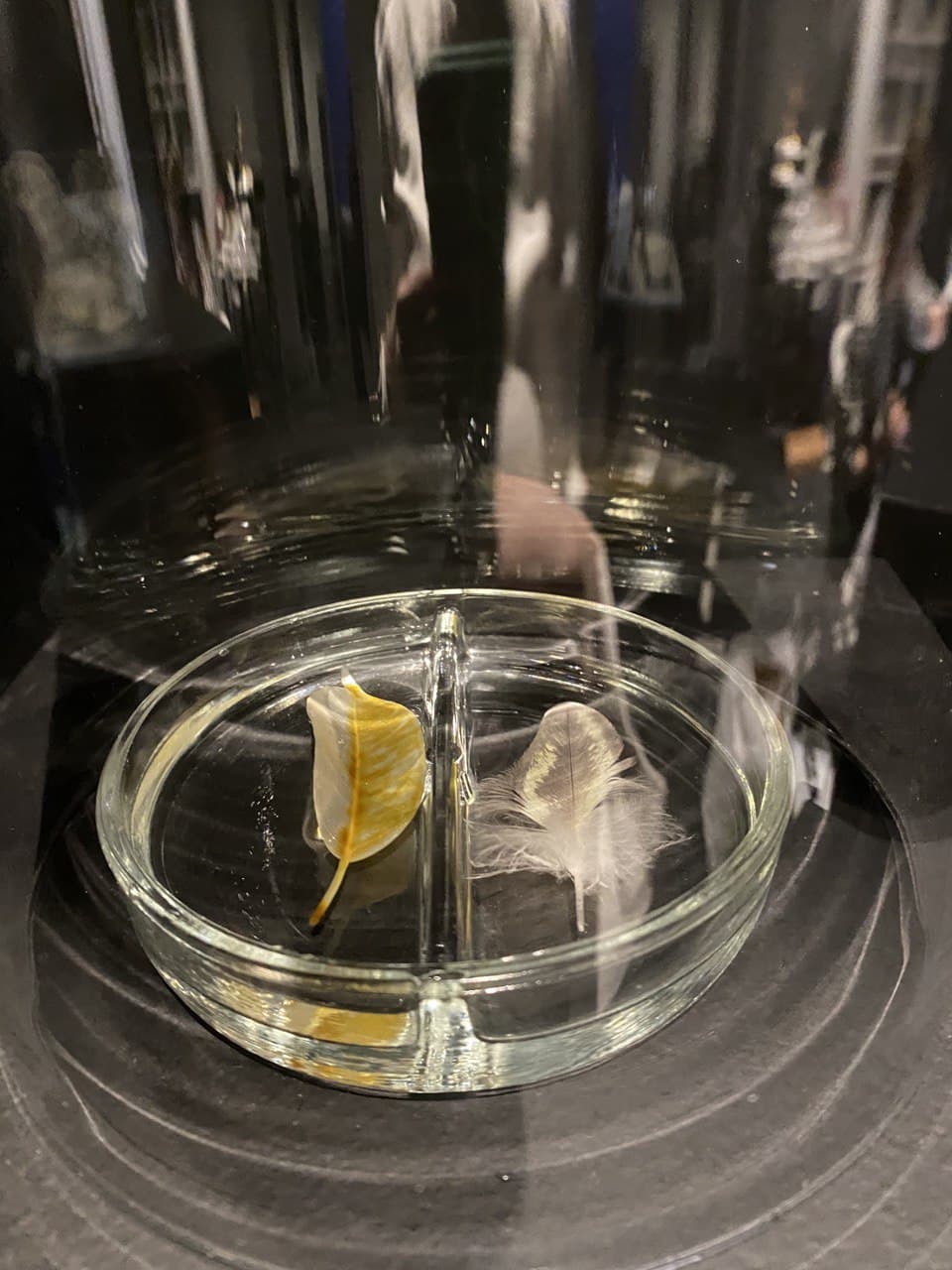Speculative research on plant-bird communication:
series of art objects
series of art objects
Hi everyone! I’m Pauline and in this project I’m focusing on the interspecies communication between a parrot and a plant. This project was inspired by the symbiogenesis theory which holds that species survive due to their cooperation, not competition.
The speculative research of the interaction between birds and plants comprises a series of art objects:
The speculative research of the interaction between birds and plants comprises a series of art objects:
№1
The first is a SymbioDevice that collects data from the two species to analyze their interaction
№2
The second is an artificial feather created from a decellularized plant leaf which, we believe, will help birds overcome the disease that makes them lose their feathers
№3
The third one is training a neural network to understand and produce bird’s signs: in a future symbiotic ecosystem Artificial Intelligence will analyze cocktail signs together with plants’ signals to facilitate and expand interspecies interactions.








GALLERY












Thus, as part of speculative research, we produced three art objects: SymbioDevice, an artificial feather, and also taught the neural network to identify and produce cocktail singing as domestic cockatiels.
This project can serve as a prototype of a hybrid ecosystem of the future, where, with the help of biotechnology and artificial intelligence, not only the existing interspecies communications are being researched and facilitated, but also new ones are created.
1
Parrot, and 3 plants
81
page thesis
3
art objects and 3 bioexperiments
Short explanation
Video documentation
Art objects








OBJECT 01
We started to analyze the interspecies communication between a domestic cockatiel and plants from a series of experiments.
During the first experiment we grew oats from grains and studied the correlation between the plant’s growth rate and the water used.
We divided the oats into three groups. Each group received either water, a mixture of water with the parrot’s droppings or the water from the parrot drinker.
The oats fertilized with the mixture of water and droppings grew better than the group that received only water. The reason is that bird droppings are a mineral fertilizer and contain water, digested organic matter such as grains or their husks, as well as nitrogen, calcium, potassium and phosphorus, which are important for plants’ growth.
However, the fastest growing group was the one that received water from the parrot drinker. We assume it’s because the water contains not only the parrot’s droppings but also feather microbiota, which makes it richer in nutrients useful for the plant.
In the second experiment we grew the bacteria from the feathers and the parrot’s feet in Petri dishes in order to educe its microbiome. Here’s what we saw through the microscope.
The results of the experiments showed what affects the interaction between birds and plants and how to measure it. We then used this data to create a SymbioDevice.
SymbioDevice is a prototype of the future gadget that would collect data from the two species’ interactions in order to analyze them later. Based on the temperature, air humidity and lighting intensity, the device provides the optimal watering and lighting for a plant. The device then combines the information with the bird microbiome data that ensure the organic substance to nurture the plants. This way, the device records the evidence that the interspecies care took place.
During the first experiment we grew oats from grains and studied the correlation between the plant’s growth rate and the water used.
We divided the oats into three groups. Each group received either water, a mixture of water with the parrot’s droppings or the water from the parrot drinker.
The oats fertilized with the mixture of water and droppings grew better than the group that received only water. The reason is that bird droppings are a mineral fertilizer and contain water, digested organic matter such as grains or their husks, as well as nitrogen, calcium, potassium and phosphorus, which are important for plants’ growth.
However, the fastest growing group was the one that received water from the parrot drinker. We assume it’s because the water contains not only the parrot’s droppings but also feather microbiota, which makes it richer in nutrients useful for the plant.
In the second experiment we grew the bacteria from the feathers and the parrot’s feet in Petri dishes in order to educe its microbiome. Here’s what we saw through the microscope.
The results of the experiments showed what affects the interaction between birds and plants and how to measure it. We then used this data to create a SymbioDevice.
SymbioDevice is a prototype of the future gadget that would collect data from the two species’ interactions in order to analyze them later. Based on the temperature, air humidity and lighting intensity, the device provides the optimal watering and lighting for a plant. The device then combines the information with the bird microbiome data that ensure the organic substance to nurture the plants. This way, the device records the evidence that the interspecies care took place.
OBJECT 02
The next art object created as a part of this research is an artificial feather.
Beak and feather disease is a fatal malady that affects the beak, plumage and the immune system of a bird. In most cases birds die from secondary diseases due to the weakened immune system, and there’s still no effective cure of this disease.
A way to help birds is to create an artificial feather that can be implanted into a sick bird’s body.
To create the artificial feather we used a decellularized plant leaf. Although any plant can be used, we chose a fern leaf and a ficus leaf, since they bear the most resemblance to a feather.
In order to decellularize a leaf, mix chlorine with detergent and water. Put a leaf into this mixture and stir daily.
Here’s what happened in about a month.
After that the center of the feather - rachis - is injected with a vitamin complex, which will help a sick bird improve its immunity and implant the feather.
Thus, with the help of biotechnology we create new forms of interspecies interaction, where the plant helps the parrot.
Beak and feather disease is a fatal malady that affects the beak, plumage and the immune system of a bird. In most cases birds die from secondary diseases due to the weakened immune system, and there’s still no effective cure of this disease.
A way to help birds is to create an artificial feather that can be implanted into a sick bird’s body.
To create the artificial feather we used a decellularized plant leaf. Although any plant can be used, we chose a fern leaf and a ficus leaf, since they bear the most resemblance to a feather.
In order to decellularize a leaf, mix chlorine with detergent and water. Put a leaf into this mixture and stir daily.
Here’s what happened in about a month.
After that the center of the feather - rachis - is injected with a vitamin complex, which will help a sick bird improve its immunity and implant the feather.
Thus, with the help of biotechnology we create new forms of interspecies interaction, where the plant helps the parrot.
OBJECT 03
Cockatiel singing generated by a neural network serves as a biotechnological audio background of the ecosystem. The project offers an alternative scenario of a symbiotic future where technologies and nature intertwine.

SCHEDULE
Workshop with Laura at AIR ITMO
12.06 16:00
Децеллюляризация растений:
от искусства до медицины
от искусства до медицины
Workshop at Vinzavod
23.06 18:00
Децеллюляризация растений:
от искусства до медицины
от искусства до медицины
Discussion at Vinzavod
27.06 19:00
Теоретический аспект межвидовой коммуникации: Донна Харауэй, Якоб фон Икскюль, Санаура Тэйлор
Workshop at Tumen
11.07 13:00
Децеллюляризация растений:
от искусства до медицины
от искусства до медицины
symbiodevice@GMAIL.COM
